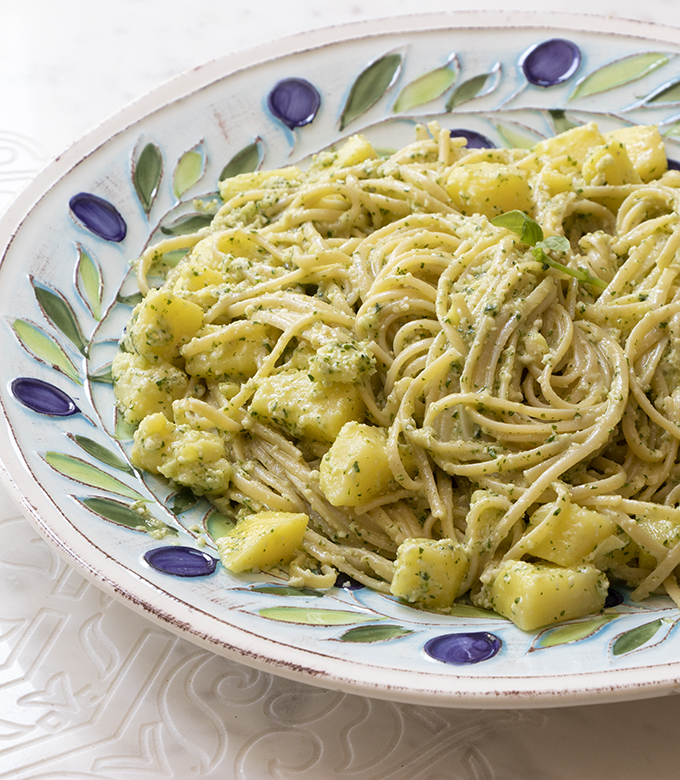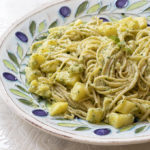
I love that most of us can blurt out, without taking time to think about it, the foods we loved as a kid. I know I can! One of my favorite foods was pesto pasta. I didn’t necessarily know what it was called back then, I just knew that I loved the “green pasta” my Sicilian mom, aunts and grandpa used to make.
With all the terrible things going on in our world right now, it’s such a great time to resort to the things we love and the places we find comfort. And for me, and I’m sure a LOT of other people, food is such a great source of comfort, isn’t it?
And I’ll bet most would consider pasta one of those traditional comfort foods. Raised among a large Italian family, it surely is a soul food for me. I will never forget Sundays at my grandmas house. It would fill up with aunts, uncles, cousins, laughter – and what seemed like endless platters of pasta, stuffed clams and peppers, imported salami and smelly cheeses, long loaves of braided Italian bread, and sugary treats like sfingi or fried dough.
So yeah, those memories – and enjoying great dishes like pasta – are a good thing right now. It reminds me of better days. It also reminds me that love is around us, whether we see it right in front of us or not.
Lately, it’s taken a little more effort than usual to look beyond what’s happening in the day-to-day and set aside time to not only thank God for the things we have, but to pray and meditate on the timeless values that Jesus talked about. I was thinking about the simple lessons He taught, like to simply love our neighbors and forgive our enemies. Just that, right there, could change the trajectory of our hearts.
But that is a whole other post, so for now I’ll just stick to sharing a few tips for this potato pesto pasta and then the recipe. I hope you enjoy it, and that it will give you and your family a few moments to embrace the simple pleasures and just be thankful for sharing a meal together.
Tips for Potato Pesto Pasta
- Potatoes: Don’t overcook the potatoes, otherwise they’ll just get mashed up during the tossing. It won’t taste bad, it might just make for a more dense texture (depending on the kind of potatoes you use). To make sure you cook until al dente, just take a nibble or poke with fork after about 15 minutes of boiling. There should still be some firmness without being crunchy. Also, I recommend using golden potatoes since they have a waxier texture and hold their form even when cubed or sliced.
- Pesto: Like with almost any kind of sauce or pesto, most folks have different things they like more or less, so keep that in mind when adding the ingredients for the pesto. For example, if you like a milder flavor, add less garlic, or roast the garlic first. Also, depending on what kind of cheese you prefer, you may find that a little salt is needed. For example, if Pecorino is used, salt may not be necessary since the cheese is already pretty salty. Just taste the pesto after the cheese is combined and add salt if needed.
- Tossing the Pesto Pasta: I think it matters how the pasta is tossed when making the pesto and potato pasta. Here are the steps I find create the consistency and taste I like. In a large shallow serving platter, add one cup of the pesto and the cooked potato cubes. Then, once the pasta is ready, add about 1/2 cup of the pasta water to the potato and pesto. Using tongs, take the pasta directly from the pot and add to the platter. With the tongs, pull the pesto and potatoes upward until incorporated. Add more pesto as needed. And then garnish with cheese if preferred.
- Parsley: The truth is, I don’t know if my aunties or grandpa added parsley to their pesto, but I think they did because of the rich color of their pesto pasta. I started adding a little bit recently and love the result. However, parley has the potential to add a bit of a grassy taste, so if you’re worried about that, don’t add it. I happen to love it.
- Pasta: I’ve used just about every kind of pasta when making this dish, but for some reason, I just love the way the potato shapes show up with linguini or spaghetti. So I guess I’m saying it doesn’t matter. 🙂
- Other Additions: Other ingredients can be added, like fresh cut green beans. This is also a Sicilian thing, but I prefer just the starch on starch for some reason. It’s the simplicity of this dish that really is the star, in my very humble opinion. But you do you! ha!

Walnut Pesto & Potato Pasta
Equipment
- Food processor or mortar and pestle, or high-powered blender (like a Vitamix).
Ingredients
- 2 golden potatoes peeled, cubed
- 1 pound pasta spaghetti, linguini, boccoli or penne (whichever you prefer)
- 1 Tbsp kosher salt to add to the water before cooking the pasta
- 1 tsp optional: crushed red pepper
For the Pesto Sauce
- 1 cup packed fresh basil leaves about 15 basil leaves
- 1/4 cup fresh parsley
- 5 cloves fresh garlic
- 1/4 cup olive oil
- 1/4 cup walnuts
- 1/2 lemon squeezed
- 1/2 cup Pecorino Romano or Parmigiano freshly grated
Instructions
- Peel potatoes and cut in 1-inch cubes.
- Fill medium sized pot with water and bring to a boil. Add 2 tsp of kosher salt, add the potatoes and cook until tender, but al dente, about 20 minutes. Set aside to drain in colander.
- Rinse basil leaves and pat dry; set aside.
- To prepare the pesto, add basil leaves to a food processor, along with parsley, garlic, olive oil, walnuts and process by pulsing until a paste forms.. Add lemon juice and transfer mixture to a medium sized bowl; give it a stir. Add grated Pecorino cheese (a little at a time, tasting in between for taste and texture since you may not want to use all the cheese) and gently stir until well-blended. Taste and add more olive oil and or cheese until desired taste and consistency. Note: Flavors might be a little intense at first. If preferred, make a day ahead and refrigerate in air tight container to give flavors a chance to blend and mellow. Optional: For a less pungent garlic flavor, sauté the garlic in a little olive oil for about two minutes before processing the pesto.
- Fill a large, heavy-bottomed pot with water and bring to a boil over high heat. Add 1 tablespoon salt and the pasta and cook according to the directions on the package until al dente. Reserve one cup of the pasta cooking water in a glass measuring cup.
- To a large serving bowl, add half the pesto mixture to the bottom of the bowl and about a cup of the chopped potatoes.
- When the pasta is ready, add about 1/2 cup of the pasta water on top of the pesto and potatoes. Then add the pasta to the pesto and potato. Using tongs, gently toss together to combine, pulling upward until the pesto coats the pasta, and adding more of the reserved cooking liquid as needed. Add the remaining pesto and continue to gently toss.
- Garnish with additional grated cheese and crushed red pepper if desired.

Leave a Reply